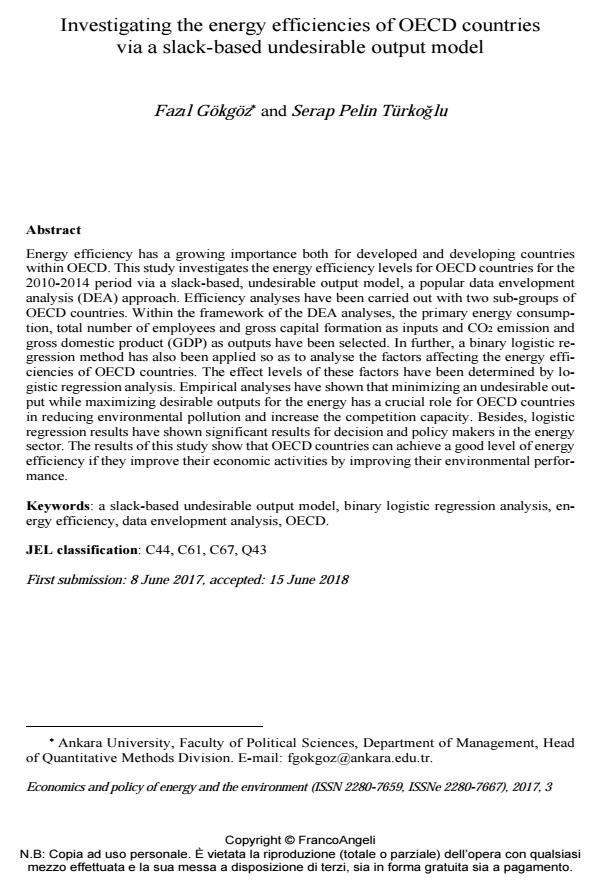Investigating the energy efficiencies of OECD countries via a slack-based undesirable output model
Journal title ECONOMICS AND POLICY OF ENERGY AND THE ENVIRONMENT
Author/s Fazil Gokgoz, Serap Pelin Turkoglu
Publishing Year 2018 Issue 2017/3
Language Italian Pages 22 P. 73-94 File size 249 KB
DOI 10.3280/EFE2017-003005
DOI is like a bar code for intellectual property: to have more infomation
click here
Below, you can see the article first page
If you want to buy this article in PDF format, you can do it, following the instructions to buy download credits

FrancoAngeli is member of Publishers International Linking Association, Inc (PILA), a not-for-profit association which run the CrossRef service enabling links to and from online scholarly content.
Energy efficiency has a growing importance both for developed and developing countries within OECD. This study investigates the energy efficiency levels for OECD countries for the 2010-2014 period via a slack-based, undesirable output model, a popular data envelopment analysis (DEA) approach. Efficiency analyses have been carried out with two sub-groups of OECD countries. Within the framework of the DEA analyses, the primary energy consumption, total number of employees and gross capital formation as inputs and CO2 emission and gross domestic product (GDP) as outputs have been selected. In further, a binary logistic regression method has also been applied so as to analyse the factors affecting the energy efficiencies of OECD countries. The effect levels of these factors have been determined by logistic regression analysis. Empirical analyses have shown that minimizing an undesirable output while maximizing desirable outputs for the energy has a crucial role for OECD countries in reducing environmental pollution and increase the competition capacity. Besides, logistic regression results have shown significant results for decision and policy makers in the energy sector. The results of this study show that OECD countries can achieve a good level of energy efficiency if they improve their economic activities by improving their environmental performance.
Keywords: A slack-based undesirable output model, binary logistic regression analysis, energy efficiency, data envelopment analysis, OECD.
Jel codes: C44, C61, C67, Q43
- Technical Efficiency and Productivity Change in the European Union with Undesirable Output Considered Djula Borozan, in Energies /2021 pp.4937
DOI: 10.3390/en14164937 - Role of climate fund raising under fiscal balance on climate change mitigation: an analysis from Pareto optimality Jie Ding, Ying Wang, Siqi Wang, Muhammad Mohsin, in Environmental Science and Pollution Research /2022 pp.19047
DOI: 10.1007/s11356-022-22620-w
Fazil Gokgoz, Serap Pelin Turkoglu, Investigating the energy efficiencies of OECD countries via a slack-based undesirable output model in "ECONOMICS AND POLICY OF ENERGY AND THE ENVIRONMENT" 3/2017, pp 73-94, DOI: 10.3280/EFE2017-003005